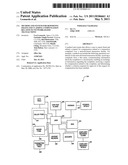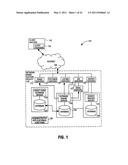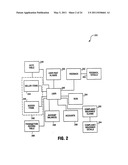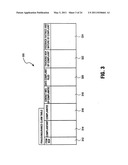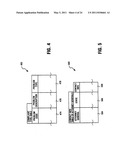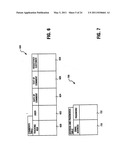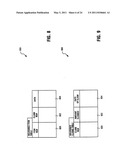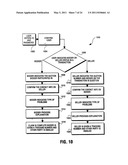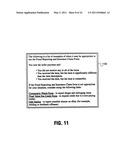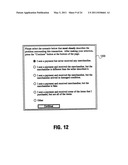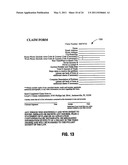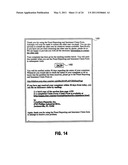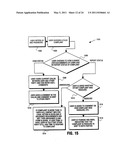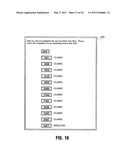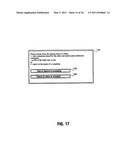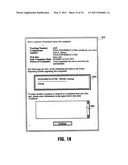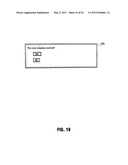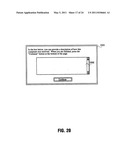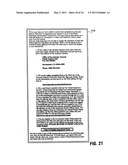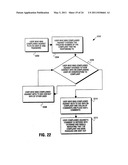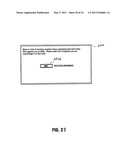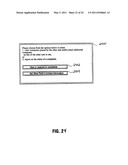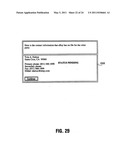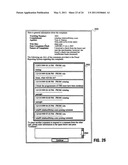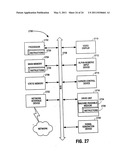Patent application title: METHOD AND SYSTEM FOR REPORTING FRAUD AND CLAIMING COMPENSATION RELATED TO NETWORK-BASED TRANSACTIONS
Inventors:
Lou Leonardo (Aptos, CA, US)
Gurinder Singh Grewal (Fremont, CA, US)
Rob Ratterman (Villa Hills, KY, US)
Josh Knepfle (Cincinnati, OH, US)
Randy Ching (Mountain View, CA, US)
Tola Dalton (Ben Lomond, LA, US)
IPC8 Class: AG06Q3000FI
USPC Class:
705 2641
Class name: Automated electrical financial or business practice or management arrangement electronic shopping third party assisted
Publication date: 2011-05-05
Patent application number: 20110106661
allows a user to report fraud and submit a
request for compensation related to a transaction completed over a
network-based transaction facility. For example, a method can include the
following operations conducted via the network-based transaction
facility: receiving a complaint from a first party, communicating
information about the complaint to a second party, enabling an exchange
of information regarding the complaint, receiving a request for
compensation related to the complaint, and determining whether a
criterion required for approval of the request for compensation has been
satisfied.Claims:
1. A method comprising: receiving a complaint, at a network-based
transaction facility, from a first party regarding a transaction with a
second party completed over the network-based transaction facility
operated by a third party; communicating, via the network-based
transaction facility, information about the complaint to the second
party; enabling the first party and the second party to exchange
additional information related to the complaint in order to facilitate
resolution of the complaint; receiving, from the first party at the
network-based transaction facility, a request for compensation related to
the transaction with the second party, the request for compensation based
on the complaint; and determining whether the first party has complied
with a criterion required for approval of the request for compensation.
2. The method of claim 1, wherein the determining whether the first party has complied with the criterion includes determining that the complaint has been open for a pre-determined time period.
3. The method of claim 1, wherein the determining whether the first party has complied with the criterion includes determining that the first user has not exceeded a number of requests for compensation within a certain time period.
4. The method of claim 1, wherein the determining whether the first party has complied with the criterion includes determining that the value of the transaction transgressed a certain threshold amount.
5. The method of claim 1, wherein the receiving the complaint includes receiving a complaint regarding potential fraud by the second party.
6. The method of claim 5, wherein the potential fraud includes a form of fraud selected from the following group of fraudulent activities: the second party receiving payment but failing to deliver purchased item; the second party delivering a defective item; the second party delivering an item that differs from an advertised item; or the second party delivering a counterfeit item.
7. The method of claim 1, wherein the determining whether the first party has complied with the criterion includes determining that the first party has attempted to communicate with the second party via the network-based transaction facility.
8. The method of claim 1, further including receiving, via the network-based transaction facility, an indication of complaint resolution.
9. The method of claim 8, wherein the receiving the indication of complain resolution includes receiving approval of the compensation request received at the network-based transaction facility from the first party.
10. The method of claim 9, wherein the receiving the indication of complain resolution triggers compensation, based on the compensation request, to the first party.
11. The method of claim 8, wherein the receiving the indication of complain resolution includes receiving a notification from the first party that the complaint has been resolved through communication with the second party.
12. A tangible machine-readable storage medium containing instructions, which when executed on a network-based transaction facility, cause the network-based transaction facility to: receive a complaint from a first party regarding a transaction with a second party completed over the network-based transaction facility operated by a third party; communicate information about the complaint to the second party; enable the first party and the second party to exchange additional information related to the complaint in order to facilitate resolution of the complaint; receive, from the first party, a request for compensation related to the transaction with the second party, the request for compensation based on the complaint; and determine whether the first party has complied with a criterion required for approval of the request for compensation.
13. The tangible machine-readable storage medium of claim 12, wherein the instructions which cause the machine to determine whether the first party has complied with the criterion include instructions which cause the machine to determine that the complaint has been open for a certain time period.
14. The tangible machine-readable storage medium of claim 12, wherein the instructions which cause the machine to determine whether the first party has complied with the criterion include instructions which cause the machine to determine that the first user has not exceeded a number of requests for compensation within a certain time period.
15. The tangible machine-readable storage medium of claim 12, wherein the instructions which cause the machine to determine whether the first party has complied with the criterion include instructions which cause the machine to determine that the value of the transaction transgressed a certain threshold amount.
16. The tangible machine-readable storage medium of claim 12, wherein the instructions which cause the machine to receive the complaint include instructions which cause the machine to receive a complaint regarding potential fraud by the second party.
17. The tangible machine-readable storage medium of claim 12, wherein the potential fraud includes a form of fraud selected from the following group of fraudulent activities: the second party receiving payment but failing to deliver purchased item; the second party delivering a defective item; the second party delivering an item that differs from an advertised item; or the second party delivering a counterfeit item.
18. The tangible machine-readable storage medium of claim 12, wherein the instructions which cause the machine to determine whether the first party has complied with the criterion include instructions which cause the machine to determine that the first party has attempted to communicate with the second party via the network-based transaction facility.
19. The tangible machine-readable storage medium of claim 12, wherein the machine-readable medium further includes instructions which cause the machine to resolve the complaint.
20. The tangible machine-readable storage medium of claim 19, wherein the instructions which cause the machine to resolve the complaint include instructions which cause the machine to approve the compensation request received from the first party.
21. The tangible machine-readable storage medium of claim 20, wherein the instructions which cause the machine to resolve the complaint include instructions which cause the machine to compensate the first party based on the approved compensation request.
22. The tangible machine-readable storage medium of claim 19, wherein the instructions which cause the machine to resolve the complaint include instructions which cause the machine to receive an indication from the first party that the complaint has been resolved through communication with the second party.
23. A tangible machine-readable storage medium containing instruction, which when executed on a mobile computing device, cause the mobile computing device to: send a complaint to a network-based transaction facility, the complaint associated with a transaction completed over the network-based transaction facility with a second party; exchange information regarding the complaint, via the network-based transaction facility, with the second party; send a request for compensation to the network-based transaction facility, the request for compensation based on the complaint; and receive an approval of the request for compensation from the network-based transaction facility, the approval based on the request complying with a compensation criterion.Description:
RELATED APPLICATIONS
[0001] This application is a continuation of U.S. application Ser. No. 09/583,216, filed on May 30, 2000, which is incorporated herein by reference in its entirety.
FIELD OF THE INVENTION
[0002] The present invention relates generally to the field of e-commerce. More particularly, the present invention relates to a method and system for reporting fraud and claiming compensation related to network-based transactions.
BACKGROUND OF THE INVENTION
[0003] A common type of network-based transaction is purchasing goods or services via a network-based transaction facility, e.g., a website on the Internet. A common problem associated with such network-based transactions is fraud. For example, a seller may defraud a buyer and vice versa a buyer may defraud a seller. One type of network-based transaction is an online-auction transaction. In an online-auction transaction, a seller may offer an item for sale via an auction website in which a number of bidders access the website and bid for the item. A transaction is completed after the winning bidder pays for the item and the seller delivers the item to the winning bidder.
[0004] However, a seller may defraud a winning bidder, e.g., by accepting payment of an auctioned item and not delivering the item, delivering the item defective, delivering the item that is different than an advertised description of the item, or delivering a counterfeit item. Alternatively, a winning bidder may defraud a seller, e.g., by sending an incorrect amount of payment, sending a form of payment that is defective, or sending a form of payment with insufficient funds.
[0005] Thus, there is a need to allow users to report and settle potential fraud cases and, if transactions are fraudulent, allow users to file insurance claims for such transactions in which financial loss has occurred.
SUMMARY OF THE INVENTION
[0006] A method and system for reporting fraud and claiming insurance related to network-based transactions are disclosed. For one embodiment, a submission of a complaint is facilitated to a network-based facility in which the complaint relates to a network-based transaction. The complaint is associated with an identifier. A resolution of the complaint associated with the identifier is facilitated, and if the complaint is not resolved, an insurance claim is facilitated for the unresolved complaint.
[0007] Other features of the present invention will be apparent form the accompanying drawings and from the detailed description that follows.
BRIEF DESCRIPTION OF THE DRAWINGS
[0008] The present invention is illustrated by way of example and not limited by the figures of the accompanying drawings, in which like references indicate similar elements and in which:
[0009] FIG. 1 is a block diagram illustrating an exemplary network-based transaction facility in the form of an internet-based auction facility;
[0010] FIG. 2 is a database diagram illustrating an exemplary database for the transaction facility;
[0011] FIG. 3 is a diagrammatic representation of an exemplary fraud/insurance claim table of the database illustrated in FIG. 2;
[0012] FIG. 4 is a diagrammatic representation of an exemplary complaint type table of the database illustrated in FIG. 2;
[0013] FIG. 5 is a diagrammatic representation of an exemplary contact information table of attorney generals of the database illustrated in FIG. 2;
[0014] FIG. 6 is a diagrammatic representation of an exemplary comments table of the database illustrated in FIG. 2;
[0015] FIG. 7 is a diagrammatic representation of an exemplary address and password table of the database illustrated in FIG. 2;
[0016] FIG. 8 is a diagrammatic representation of an exemplary insurance claim table of the database illustrated in FIG. 2;
[0017] FIG. 9 is a diagrammatic representation of an exemplary insurance claim details table of the database illustrated in FIG. 2;
[0018] FIG. 10 is a flow chart illustrating an exemplary operation for allowing a user to file a claim or complaint facilitated by a network-based transaction facility;
[0019] FIG. 11 illustrates an exemplary introduction interface for reporting fraud and claiming insurance;
[0020] FIG. 12 illustrates an exemplary interface providing options for a user to select relating to common problems surrounding a transaction;
[0021] FIG. 13 illustrates an exemplary interface of a claim or complaint form;
[0022] FIG. 14 illustrates an exemplary interface providing a user a tracking number and options checking the status of a complaint;
[0023] FIG. 15 is a flow chart illustrating an exemplary operation allowing users to view the status of a claim or to provide comments to a complaint;
[0024] FIG. 16 illustrates an exemplary interface allowing a user to select a claim to inquire the status of the complaint;
[0025] FIG. 17 illustrates an exemplary interface allowing a user to select to view or respond to a claim or report status of a complaint;
[0026] FIG. 18 illustrates an exemplary interface providing a user with information regarding a complaint and allowing a user to provide comments regarding the complaint;
[0027] FIG. 19 illustrates an exemplary interface allowing user to indicate if a complaint is resolved;
[0028] FIG. 20 illustrates an exemplary interface allowing a user to explain how a complaint was resolved;
[0029] FIG. 21 illustrates an exemplary interface providing a user with options for an unresolved complaint and allowing a user to file an insurance claim form;
[0030] FIG. 22 is a flow chart illustrating an exemplary operation allowing a user who identified as committing fraud to view the complaint against the user and provide comments;
[0031] FIG. 23 illustrates an exemplary interface providing a user who is identified as committing fraud options to view or respond to a complaint or obtain contact information of the party who filed the complaint;
[0032] FIG. 24 illustrates an exemplary interface providing a user a list of tracking numbers of complaints against the user;
[0033] FIG. 25 illustrates an exemplary interface providing contact information of a user who has filed a complaint;
[0034] FIG. 26 illustrates an exemplary interface for providing general information about a complaint and allowing a user to provide comments in response to comments from a complaining user; and
[0035] FIG. 27 is a diagrammatic representation of a machine, in an exemplary form of a computer system, in which a set of instructions for causing the machine to perform any of the methodologies of the present invention may be executed.
DETAILED DESCRIPTION
[0036] A method and system for reporting fraud and claiming insurance related to network-based transactions are described. For one embodiment, a submission of a complaint is facilitated to a network-based facility in which the complaint relates to a network-based transaction. The complaint is associated with an identifier. A resolution of the complaint associated with the identifier is facilitated, and if the complaint is not resolved, an insurance claim is facilitated for the unresolved complaint.
[0037] The method and system described herein allow users to report and settle potential fraud cases. For example, a network-based facility allows users to detail their complaints related to network-based transactions and to provide a process allowing users to resolve their complaints. Furthermore, if transactions are fraudulent, the method and system described herein allow users to file an insurance claim in which a financial loss has occurred. For example, if a complaint cannot be resolved, users are allowed to claim insurance for unresolved transactions under certain criteria.
[0038] In the following embodiments, for purposes of explanation, numerous specific details are set forth in order to provide a thorough understanding of the present invention. It will be evident, however, to one skilled in the art that the present invention may be practiced without these specific details.
Terminology
[0039] In the following embodiments, the term "transaction" or "transactions" shall be taken to include any communications between two or more entities and shall be construed to include, but not limited to, commercial transactions including sale and purchase transactions, online-auction transactions and the like.
Transaction Facility
[0040] FIG. 1 is block diagram illustration of an exemplary network-based transaction facility 100 in the form of an "Internet" network-based auction facility 110. While an exemplary embodiment of the present invention is described within the context of an auction facility, it will be appreciated by those skilled in the art that the invention will find application in many different types of computer-based, and network-based, commerce facilities.
[0041] The auction facility 110 includes one or more of a number of types of front-end servers, namely page servers 112 that deliver web pages (e.g., markup language documents), picture servers 114 that dynamically deliver images to be displayed within Web pages, listing servers 116, CGI servers 118 that provide an intelligent interface to the back-end of facility 110, and search servers 120 that handle search requests to the facility 110. Email servers 121 provide, inter alia, automated email communications to users of the facility 110. Auction facility 110 also includes administrative application(s) functions 128 for providing functions for applications running on auction facility 110.
[0042] The back-end servers include a database engine server 122, a search index server 124 and a credit card database server 126, each of which maintains and facilitates access to respective databases 123, 125, and 127, respectively.
[0043] The Internet-based auction facility 110 may be accessed by a client program 130, such as a browser (e.g., the Internet Explorer distributed by Microsoft Corp. of Redmond, Wash.) that executes on a client machine 132 and accesses the facility 110 via a network such as, for example, the Internet 134. Other examples of networks that a client may utilize to access the auction facility 110 include a wide area network (WAN), a local area network (LAN), a wireless network (e.g., a cellular network), or the Plain Old Telephone Service (POTS) network.
Database Structure
[0044] FIG. 2 is a database diagram illustration of an exemplary database 200, maintained by and accessed via the database engine server 122, which at least partially implements and supports the network-based auction facility 110. Database 123 may, in one embodiment, be implemented as a relational database, and includes a number of tables having entries, or records, that are linked by indices and keys. In an alternative embodiment, database 123 may be implemented as collection of objects in an object-oriented database.
[0045] Central to the database 123 is a user table 240, which contains a record for each user of the auction facility 210. A user may operate as a seller, buyer, or both, within auction facility 110. Database 123 also includes item tables 242 that may be linked to the user table 240. Specifically, tables 242 include a seller items table 244 and data items table 246. A user record in user table 240 may be linked to multiple items that are being, or have been, auctioned via auction facility 110. A link indicates whether the user is a seller or a bidder (or buyer) with respect to items for which records exist within the item tables 242. Database 123 also includes a note table 248 populated with note records that may be linked to one or more item records within the item tables 242 and/or to one or more user records within the user table 240. Each note record within the table 248 may include, inter alia, a comment, description, history or other information pertaining to an item being auction via auction facility 110, or to a user of auction facility 110.
[0046] A number of other tables are also shown to be linked to the user table 240, namely a user past aliases table 250, a feedback table 252, a feedback details table 253, a bids table 254, an accounts table 256, an account balances table 258, a transaction record table 260, a complaint/insurance claims table 262, and a complaint/insurance details table 264.
Complaint and Insurance Transaction Record Tables
[0047] FIGS. 3-9 are diagrammatic representations of exemplary embodiments of transaction record tables that are populated with records or entries for complaints and insurance claims relating to transactions (e.g., Internet based auction transactions) that have been facilitated by auction facility 110. Such transaction record tables may be stored in complaint/insurance claims table 262 and/or complaint/insurance details table 264.
[0048] FIG. 3 is a diagrammatic representation of an exemplary fraud/insurance claim table 300 of the database illustrated in FIG. 2. Referring to FIG. 3, fraud/insurance claim table 300 includes item number column 312, complaintant column 314, complaintee column 316, contact info of complaintee column 318, date complaint filed column 320, tracking number of complaint column 322, and feedback ratings and nature of complaint column 324.
[0049] Item number column 312 stores item identifiers related to an item that is subject to a filed complaint. Complaintant column 314 stores the names of users who have filed a complaint for items identical in item number column 312. Complaintee column 316 stores names of users in which a complaint has been filed against. Contact information of complaintee column 318 stores information, which may be used to contact the complaintee. For example, such contact information may include an email address and/or mailing address or phone number of the complaintee.
[0050] Date complaint filed column 320 stores the times and dates a complaint is filed within auction facility 110. Tracking number of complaint column 322 stores tracking numbers that identify a filed complaint. The tracking number is used to track the status of a complaint. Feedback ratings and nature of a complaint column 324 stores information that describes the nature of the complaint, for example, how a fraud has been committed on a user.
[0051] FIG. 4 is a diagrammatic representation of an exemplary complaint type table 400 of the database illustrated in FIG. 2. Referring to FIG. 4, complaint type table 400 includes problem code column 474, problem description column 476, and problem type column 478.
[0052] Problem code column 474 stores a code number related to a type of problem description. Problem description column 476 stores description information relating to the complaint. For example, a common problem description may be "I sent the money for the item, but never received it." Problem type column 478 stores information used to tell whether the problem is specific to a buyer-bidder or a seller.
[0053] FIG. 5 is a diagrammatic representation of an exemplary contact information table of attorney generals 500 of the database illustrated in FIG. 2. Referring to FIG. 5, contact information table of attorney generals 500 includes an attorney general column 584, state column 586, and contact information column 588.
[0054] Attorney general column 584 stores names of attorney generals in specific states to contact in reporting fraud. That is, a user may contact an attorney general to describe specifically a fraud that has occurred against the user in a particular state. State column 586 stores the name of the state of the corresponding attorney general in the attorney general column 584. Contact information column 588 stores contact information for an attorney general in the attorney general column 584. Such contact information may include the mailing address, telephone number, or emailing address of an attorney general.
[0055] FIG. 6 is a diagrammatic representation of an exemplary comments table 600 of the database illustrated in FIG. 2. Comments table 600 may store comments placed by both parties in connection with a complaint. One record may be stored for each comment placed by each user. A limit on the number of comments may be placed for each user for each complaint. Referring to FIG. 6, comments table 600 includes tracking number column 620, user column 622, date of comment column 624, text of comment column 626, and registered customer column 628.
[0056] Tracking number column 620 stores tracking numbers that identifies filed complaints. User column 622 stores the names of users who have placed a comment in connection with a filed complaint associated with the tracking number stored in tracking number column 620. The user may be a bidder or a seller. Date of comment column 624 stores date and time information indicating when the comment was entered. Text of comment column 626 stores the text of a comment provided by a user in user column 622. For example, the user may provide information on how the user was defrauded in the online-auction transaction. Non-registered customer column 628 stores information relating to a non-registered commenting user of auction facility 110. For example, if the commenting user is not a registered user or the complaint is based on an item, which has been removed from the database, the email address of the commenting party may be placed here.
[0057] FIG. 7 is a diagrammatic representation of an exemplary address and passwords table 700 of the database illustrated in FIG. 2. Referring to FIG. 7, address and passwords table 700 includes email address column 720 and password column 722. Email address column 720 stores the email addresses of users involved with a complaint. Password column 722 stores the passwords corresponding to user email addresses in email address column 720.
[0058] Address and passwords table 700 may also store addresses and passwords of users who are not registered or cannot be found. Table 700 may also store information for users who cannot remember the user name of the other party in order to contact the other party. Table 700 may also store information to file claims on items that have been removed from the database.
[0059] FIG. 8 is a diagrammatic representation of an exemplary insurance claim table 800 of the database illustrated in FIG. 2. For one embodiment, item data is held for a limited amount of time (e.g., 30 days) and stores item data until the data is instructed to be taken off the database by auction facility 110.
[0060] Referring to FIG. 8, insurance claim table 800 includes item number column 820, claim number 822, and data column 824. Item number column 820 includes item numbers related to filed complaints that have not been resolved. Claim number column 822 stores claim numbers that are associated with item numbers in item number column 820. Data column 824 stores information relating to the item, e.g., what type of item is the subject of a complaint, the final bid price for the item, and other types of item data.
[0061] FIG. 9 is a diagrammatic representation of an exemplary insurance claim details table 900 of the database illustrated in FIG. 2. Referring to FIG. 9, insurance claims table 900 includes claim number column 920, amount claimed column 922, and date of claim column 924.
[0062] Claim number column 920 stores claim numbers related to filed complaints that have not been resolved. Amount claim column 922 stores information on the amount of money lost resulting from an online-auction transaction conducted on auction-facility 110. Date of claim column 924 stores dates in which an insurance claim was filed.
[0063] The above record tables are used by network facility 110 to provide services such that users of network facility 110 may file complaints and to claim insurance for transactions conducted on network facility 110 in which a financial loss has occurred.
[0064] In the following operations, users are allowed to file a complaint of fraud on an item they have sold or bought on the network facility. The complained against party in the transaction is notified that a complaint has been filed against that party. The complained against party is allowed to go to the network facility to explain the allegations and to resolve the complaint with the complaining party. If at any time, the complaint is resolved, the complaining party may return to the site and indicate this fact. If, after a certain period of time, the complaint is not resolved, the complaining party is given information about government agencies to contact as well as information on filing an insurance claim if the certain criteria are met.
Filing a Complaint
[0065] FIG. 10 is a flow chart illustrating an exemplary operation 1000 for allowing a user to file a claim or complaint facilitated by a network-based transaction facility. The following exemplary operation 1000 allows a user to file a complaint of fraud on an item that has been sold or bought on network facility 110. The other party in the transaction may receive an email indicating that someone has claimed that the other party has committed a fraud.
[0066] Prior to a user filing a complaint, the user may be presented with various examples of when a complaint should be filed. For example, as shown in FIG. 11, auction facility 110 may provide a user with a screen 1100 giving the user examples of when to report fraud and claim insurance. Screen 1100 may include information regarding agencies or entities that may deal with fraud and provide insurance for network-based transactions.
[0067] Referring to FIG. 10, at operation block 1002, to begin filing a complaint regarding a network-based transaction, a user inputs a user ID and password to access the complaint filing section of the auction facility 110. The user ID and password is validated.
[0068] At operation block 1004, if the user ID and password is valid, network facility 110 provides the user with an interface that details contact information of the user and asks the user to confirm the contact information.
[0069] At operation block 1006, network facility 110 provides the user with an interface asking the user to indicate whether the user is a bidder or a seller in a transaction in which a complaint is to be filed.
Complaint by Bidder
[0070] At operation block 1008, if the user is a buyer or a bidder, the bidder indicates the item number of the transaction the user believes is fraudulent.
[0071] At operation block 1010, the bidder confirms the contact information of the seller who sold the item in question to validate that the information the bidder has on the seller is the same as the records stored in network facility 110.
[0072] At operation block 1012, the bidder indicates the type of problems that occurred in which the bidder considers fraudulent. Network facility 110 may provide an interface such as that shown in screen 1200 of FIG. 12. Screen 1200 provides common problems that a bidder may select to describe the transaction. For example, one common problem a bidder may select is "I sent a payment but never received any merchandise."
[0073] At operation block 1014, the bidder fills out a complaint form and provides an explanation of occurrences during the transaction. For example, network facility 110 may provide a complaint form interface 1300 as shown in FIG. 13. Complaint form interface 1300 may ask the user to input information related to the transaction and to provide a complete description of problem.
[0074] At operation block 1016, after the bidder completes the complaint form such as complaint form 1300, the complaint process is completed. Network facility 110 then creates a tracking number, which is associated with the filed complaint for users to use to track the status of the complaint. For example, network facility 110 may provide an interface 1400, as shown in FIG. 14, indicating a tracking number. Interface 1400 provides a user a tracking number 1402 and options for the user to select if the complaint is not resolved.
Complaint by Seller
[0075] The operations and interfaces provided to a seller who is claiming fraud is similar to the operations and interfaces provided to the bidder/buyer.
[0076] At operation block 1018, if the user is a seller, the seller indicates the item number of the transaction the seller believes is fraudulent.
[0077] At operation block 1020, the seller confirms the contact information of the bidder of the item in question to validate that the information the seller has on the bidder is the same as the records stored in network facility 110.
[0078] At operation block 1022, seller indicates the type of problems that occurred during the auction transaction that seller considers fraudulent. Network facility may provide an interface similar to screen 1200 of FIG. 12 for the seller to select common problems. For example, one common problem a seller may select is "I sent the item, but the payment was insufficient."
[0079] At operation block 1024, the seller provides an explanation of what occurred during the transaction. For example, network facility 110 may provide a complaint form interface such as interface 1300 of FIG. 13 that asks the user to input information to complete the complaint and to provide a complete description of the problem.
[0080] At operation block 1026, after the seller completes the complaint form such as complaint form 1300, the complaint is completed. Network facility 110 creates a tracking number in connection with the filed complaint for users to use to track the status of the complaint. For example, network facility 110 may provide an interface 1400 indicating a tracking number.
Complaint Status/Comments
[0081] The following operation 1000 allows users to resolve complaints by providing a messaging board where both parties may comment back-and-forth about the transaction in question and to resolve a complaint. Such operations may provide the messaging board for a certain period of time (e.g., 14 days or two weeks), and, if the complaint is not resolved, such operations may provide information to the users on contacting government agencies to deal with the fraud as well as information on filing an insurance claim.
[0082] FIG. 15 is a flow chart illustrating an exemplary operation 1500 allowing users to view the status of a claim or to provide comments to a complaint.
[0083] Referring to FIG. 15, at operation block 1502, a user inputs a user ID and password to access information regarding a filed complain within network facility 110. The user ID and password are validated by network facility 110. At this point, the user may be a bidder or a seller who has filed a complaint or complaints.
[0084] At operation block 1504, if the user ID and password are valid, network facility 110 provides the user and interface listing complaints and status of complaints the user has filed. For example, network facility may provide interface 1600 as shown in FIG. 16 to the user. Interface 1600 lists tracking numbers of complaints and the status of the complaints. In the example of interface 1600, a complaint associated with the tracking number 2629 has not been resolved.
[0085] At operation block 1506, network facility 110 provides the user with interface to allow the user to choose to view current status/provide comments to a filed complaint or report the status of a filed complaint. For example, network facility 110 may provide the user with interface 1700 as shown in FIG. 17. In the example of interface 1700, the user may select option 1702 to "View or respond to complaints" or option 1704 to "Report status of complaint."
View Status or Respond to Complaint
[0086] At operation block 1508, if the user selects to view or respond to complaints, network facility 110 provides an interface for the user to view current dialog between the user and other party and can enter additional comments. For example, network facility 110 may provide an interface 1800 as shown in FIG. 18. In the example of interface 1800, a user may view all comments related to a complaint in window 1802.
[0087] At operation block 1510, the user may enter additional comments so that the other user may view in window 1804 of interface 1800. This operation is optional.
Report Status of Complaint
[0088] At operation block 1512, if the user selects to report the status of a complaint, network facility 110 provides an interface asking the user whether the complaint has been resolved. For example, network facility 110 may provide interface 1900 as shown in FIG. 19 allowing the user to select "Yes" if the complaint has been resolved and "No" if the complaint has not been resolved.
[0089] At operation block 1516, if the user selects that the complaint has been resolved, network facility 110 may provide an interface to allow the user to describe how the complaint was resolved. For example, network facility 110 may provide interface 2000 as shown in FIG. 20 allowing the user to explain how the complaint was resolved. In the example of interface 2000, a user may input the explanation in widow 2002.
[0090] At operation 1518, network facility 110 provides an interface thanking the user and sends emails to the users involved with complaint indicating that the complaint is resolved.
[0091] At operation block 1514, if the complaint is unresolved and more than 14 days old, contact information for legal services is given, and if insurance requirements are met, an insurance claim form is given. If, however, the complaint is less than 14 days old, the user is told that the other party still has time to respond to the complaint. For example, after the 14 day period, network facility 110 may provide an interface 2100 as shown in FIG. 21 providing the user with attorney general information to file a complaint.
[0092] If after the 14 day period, interface 2100 may allow the user to fill out an insurance claim form either online or to obtain a printable insurance form if certain criteria are met. Exemplary criteria may be:
[0093] Request occurs within 45 day of auction end data;
[0094] Buyer and seller feedback >0 at time of complaint;
[0095] Final bid amount is >$25.00 dollars; and
[0096] Users may file no more than one insurance claim per month for the first six months.
Responding to a Complaint
[0097] The following operation allows the other party in a transaction in which a complaint has been filed to go to the facility and provide their explanation of the events that have transpired.
[0098] FIG. 22 is a flow chart illustrating an exemplary operation 2200 allowing a user who is identified as committing fraud to view the complaint against the user and to provide comments.
[0099] Referring to FIG. 22, at operation block 2202, a user who was complained against enters a user ID and password. Network facility 110 validates the user ID and password. If the user ID and password are valid, network facility 110 allows the user to proceed to operation block 2204.
[0100] At operation block 2204, network facility provides the user with an interface to choose a tracking number of a complaint in providing a response. For example, network facility 110 may provide interface 2300 as shown in FIG. 23 listing tracking number of complaint that have been filed against the user. In the example of interface 2300, one complaint is listed 2302 to choose.
[0101] At operation block 2206, network facility 110 provides an interface to the user such that the user who was complained against can choose to view contact information on complaining user or view/respond to the complaint. For example, network facility 110 may provide interface 2400 as shown in FIG. 24 that provides option 2402 to "View or respond to complaints" or option 2404 "Get other Party's Contact Information."
[0102] At operation block 2208, if the user who was complained against chooses to view the contact information of the other user, network facility 110 provides an interface allowing the user to view the contact information of the other user. For example, network facility may provide an interface 2500 as shown in FIG. 25 that allows the user who was complained against to view the complaining user's contact information.
[0103] At operation block 2210, if the user selects to view/respond to complaint, network facility 110 provides an interface that allows the user to see information regarding the complaint, to view dialog of comments, and to place additional comments. For example, network facility 110 may provide interface 2600 as shown in FIG. 26 that allows the complained against user to view comments in window 2602 and allows the user to add additional comments in window 2604.
[0104] At operation block 2212, if the user inputs additional comments, network facility enters the additional comments into the database. The user may indicate that the complaint has been resolved. In such a case, network facility 110 will send emails to the complaining user that the complained against user has indicated that the complaint has been resolved.
Exemplary Computing System
[0105] FIG. 27 is a diagrammatic representation of a machine, in an exemplary form of a computer system 2700, in which a set of instructions for causing the machine to perform any of the methodologies of the present invention may be executed. In alternative embodiments, the machine may comprise a network router, a network switch, a network bridge, Personal Digital Assistant (PDA), a cellular telephone, a web appliance or any machine capable of executing a sequence of instructions that specify actions to be taken by that machine.
[0106] The computer system 2700 includes a process 2702, a main memory 2704 and a static memory 2706, which communicate with each other via a bus 2708. The computer system 2700 may further include a video display unit 2710 (e.g., a liquid crystal display (LCD) or a cathode ray tube (CRT)). The computer system 2700 also includes an alpha-numeric input device 2712 (e.g., a keyboard), a cursor control device 2714 (e.g., a mouse), a disk drive unit 2716, a signal generation device 2720 (e.g., a speaker) and a network interface device 2722.
[0107] The disk drive unit 2716 includes a machine-readable medium 2724 on which is stored a set instructions (i.e., software) 2726 embodying any one, or all, of the methodologies described above. The software 2726 is also shown to reside, completely or at least partially, within the main memory 2704 and/or within processor 2702. The software 2726 may further be transmitted or received via the network interface device 2722. For purposes of this specification, the term "machine-readable medium" shall be taken to include any medium that is capable of storing or encoding a sequence of instructions for execution by the machine and that cause the machine to perform any one of the methodologies of the present invention. The term "machine-readable medium" shall accordingly be taken to include, but not limited to, solid-state memories, optical and magnetic disks, and carrier wave signals.
[0108] Thus, a method and system for reporting fraud and claiming insurance related to network-based transactions have been described. Although, the present invention has been described with reference to specific exemplary embodiments, it will be evident that various modifications and changes may be made to these embodiments without departing from the broader spirit and scope of the invention. Accordingly, the specification and drawings are to be regarded in an illustrate rather than a restrictive sense.
Claims:
1. A method comprising: receiving a complaint, at a network-based
transaction facility, from a first party regarding a transaction with a
second party completed over the network-based transaction facility
operated by a third party; communicating, via the network-based
transaction facility, information about the complaint to the second
party; enabling the first party and the second party to exchange
additional information related to the complaint in order to facilitate
resolution of the complaint; receiving, from the first party at the
network-based transaction facility, a request for compensation related to
the transaction with the second party, the request for compensation based
on the complaint; and determining whether the first party has complied
with a criterion required for approval of the request for compensation.
2. The method of claim 1, wherein the determining whether the first party has complied with the criterion includes determining that the complaint has been open for a pre-determined time period.
3. The method of claim 1, wherein the determining whether the first party has complied with the criterion includes determining that the first user has not exceeded a number of requests for compensation within a certain time period.
4. The method of claim 1, wherein the determining whether the first party has complied with the criterion includes determining that the value of the transaction transgressed a certain threshold amount.
5. The method of claim 1, wherein the receiving the complaint includes receiving a complaint regarding potential fraud by the second party.
6. The method of claim 5, wherein the potential fraud includes a form of fraud selected from the following group of fraudulent activities: the second party receiving payment but failing to deliver purchased item; the second party delivering a defective item; the second party delivering an item that differs from an advertised item; or the second party delivering a counterfeit item.
7. The method of claim 1, wherein the determining whether the first party has complied with the criterion includes determining that the first party has attempted to communicate with the second party via the network-based transaction facility.
8. The method of claim 1, further including receiving, via the network-based transaction facility, an indication of complaint resolution.
9. The method of claim 8, wherein the receiving the indication of complain resolution includes receiving approval of the compensation request received at the network-based transaction facility from the first party.
10. The method of claim 9, wherein the receiving the indication of complain resolution triggers compensation, based on the compensation request, to the first party.
11. The method of claim 8, wherein the receiving the indication of complain resolution includes receiving a notification from the first party that the complaint has been resolved through communication with the second party.
12. A tangible machine-readable storage medium containing instructions, which when executed on a network-based transaction facility, cause the network-based transaction facility to: receive a complaint from a first party regarding a transaction with a second party completed over the network-based transaction facility operated by a third party; communicate information about the complaint to the second party; enable the first party and the second party to exchange additional information related to the complaint in order to facilitate resolution of the complaint; receive, from the first party, a request for compensation related to the transaction with the second party, the request for compensation based on the complaint; and determine whether the first party has complied with a criterion required for approval of the request for compensation.
13. The tangible machine-readable storage medium of claim 12, wherein the instructions which cause the machine to determine whether the first party has complied with the criterion include instructions which cause the machine to determine that the complaint has been open for a certain time period.
14. The tangible machine-readable storage medium of claim 12, wherein the instructions which cause the machine to determine whether the first party has complied with the criterion include instructions which cause the machine to determine that the first user has not exceeded a number of requests for compensation within a certain time period.
15. The tangible machine-readable storage medium of claim 12, wherein the instructions which cause the machine to determine whether the first party has complied with the criterion include instructions which cause the machine to determine that the value of the transaction transgressed a certain threshold amount.
16. The tangible machine-readable storage medium of claim 12, wherein the instructions which cause the machine to receive the complaint include instructions which cause the machine to receive a complaint regarding potential fraud by the second party.
17. The tangible machine-readable storage medium of claim 12, wherein the potential fraud includes a form of fraud selected from the following group of fraudulent activities: the second party receiving payment but failing to deliver purchased item; the second party delivering a defective item; the second party delivering an item that differs from an advertised item; or the second party delivering a counterfeit item.
18. The tangible machine-readable storage medium of claim 12, wherein the instructions which cause the machine to determine whether the first party has complied with the criterion include instructions which cause the machine to determine that the first party has attempted to communicate with the second party via the network-based transaction facility.
19. The tangible machine-readable storage medium of claim 12, wherein the machine-readable medium further includes instructions which cause the machine to resolve the complaint.
20. The tangible machine-readable storage medium of claim 19, wherein the instructions which cause the machine to resolve the complaint include instructions which cause the machine to approve the compensation request received from the first party.
21. The tangible machine-readable storage medium of claim 20, wherein the instructions which cause the machine to resolve the complaint include instructions which cause the machine to compensate the first party based on the approved compensation request.
22. The tangible machine-readable storage medium of claim 19, wherein the instructions which cause the machine to resolve the complaint include instructions which cause the machine to receive an indication from the first party that the complaint has been resolved through communication with the second party.
23. A tangible machine-readable storage medium containing instruction, which when executed on a mobile computing device, cause the mobile computing device to: send a complaint to a network-based transaction facility, the complaint associated with a transaction completed over the network-based transaction facility with a second party; exchange information regarding the complaint, via the network-based transaction facility, with the second party; send a request for compensation to the network-based transaction facility, the request for compensation based on the complaint; and receive an approval of the request for compensation from the network-based transaction facility, the approval based on the request complying with a compensation criterion.
Description:
RELATED APPLICATIONS
[0001] This application is a continuation of U.S. application Ser. No. 09/583,216, filed on May 30, 2000, which is incorporated herein by reference in its entirety.
FIELD OF THE INVENTION
[0002] The present invention relates generally to the field of e-commerce. More particularly, the present invention relates to a method and system for reporting fraud and claiming compensation related to network-based transactions.
BACKGROUND OF THE INVENTION
[0003] A common type of network-based transaction is purchasing goods or services via a network-based transaction facility, e.g., a website on the Internet. A common problem associated with such network-based transactions is fraud. For example, a seller may defraud a buyer and vice versa a buyer may defraud a seller. One type of network-based transaction is an online-auction transaction. In an online-auction transaction, a seller may offer an item for sale via an auction website in which a number of bidders access the website and bid for the item. A transaction is completed after the winning bidder pays for the item and the seller delivers the item to the winning bidder.
[0004] However, a seller may defraud a winning bidder, e.g., by accepting payment of an auctioned item and not delivering the item, delivering the item defective, delivering the item that is different than an advertised description of the item, or delivering a counterfeit item. Alternatively, a winning bidder may defraud a seller, e.g., by sending an incorrect amount of payment, sending a form of payment that is defective, or sending a form of payment with insufficient funds.
[0005] Thus, there is a need to allow users to report and settle potential fraud cases and, if transactions are fraudulent, allow users to file insurance claims for such transactions in which financial loss has occurred.
SUMMARY OF THE INVENTION
[0006] A method and system for reporting fraud and claiming insurance related to network-based transactions are disclosed. For one embodiment, a submission of a complaint is facilitated to a network-based facility in which the complaint relates to a network-based transaction. The complaint is associated with an identifier. A resolution of the complaint associated with the identifier is facilitated, and if the complaint is not resolved, an insurance claim is facilitated for the unresolved complaint.
[0007] Other features of the present invention will be apparent form the accompanying drawings and from the detailed description that follows.
BRIEF DESCRIPTION OF THE DRAWINGS
[0008] The present invention is illustrated by way of example and not limited by the figures of the accompanying drawings, in which like references indicate similar elements and in which:
[0009] FIG. 1 is a block diagram illustrating an exemplary network-based transaction facility in the form of an internet-based auction facility;
[0010] FIG. 2 is a database diagram illustrating an exemplary database for the transaction facility;
[0011] FIG. 3 is a diagrammatic representation of an exemplary fraud/insurance claim table of the database illustrated in FIG. 2;
[0012] FIG. 4 is a diagrammatic representation of an exemplary complaint type table of the database illustrated in FIG. 2;
[0013] FIG. 5 is a diagrammatic representation of an exemplary contact information table of attorney generals of the database illustrated in FIG. 2;
[0014] FIG. 6 is a diagrammatic representation of an exemplary comments table of the database illustrated in FIG. 2;
[0015] FIG. 7 is a diagrammatic representation of an exemplary address and password table of the database illustrated in FIG. 2;
[0016] FIG. 8 is a diagrammatic representation of an exemplary insurance claim table of the database illustrated in FIG. 2;
[0017] FIG. 9 is a diagrammatic representation of an exemplary insurance claim details table of the database illustrated in FIG. 2;
[0018] FIG. 10 is a flow chart illustrating an exemplary operation for allowing a user to file a claim or complaint facilitated by a network-based transaction facility;
[0019] FIG. 11 illustrates an exemplary introduction interface for reporting fraud and claiming insurance;
[0020] FIG. 12 illustrates an exemplary interface providing options for a user to select relating to common problems surrounding a transaction;
[0021] FIG. 13 illustrates an exemplary interface of a claim or complaint form;
[0022] FIG. 14 illustrates an exemplary interface providing a user a tracking number and options checking the status of a complaint;
[0023] FIG. 15 is a flow chart illustrating an exemplary operation allowing users to view the status of a claim or to provide comments to a complaint;
[0024] FIG. 16 illustrates an exemplary interface allowing a user to select a claim to inquire the status of the complaint;
[0025] FIG. 17 illustrates an exemplary interface allowing a user to select to view or respond to a claim or report status of a complaint;
[0026] FIG. 18 illustrates an exemplary interface providing a user with information regarding a complaint and allowing a user to provide comments regarding the complaint;
[0027] FIG. 19 illustrates an exemplary interface allowing user to indicate if a complaint is resolved;
[0028] FIG. 20 illustrates an exemplary interface allowing a user to explain how a complaint was resolved;
[0029] FIG. 21 illustrates an exemplary interface providing a user with options for an unresolved complaint and allowing a user to file an insurance claim form;
[0030] FIG. 22 is a flow chart illustrating an exemplary operation allowing a user who identified as committing fraud to view the complaint against the user and provide comments;
[0031] FIG. 23 illustrates an exemplary interface providing a user who is identified as committing fraud options to view or respond to a complaint or obtain contact information of the party who filed the complaint;
[0032] FIG. 24 illustrates an exemplary interface providing a user a list of tracking numbers of complaints against the user;
[0033] FIG. 25 illustrates an exemplary interface providing contact information of a user who has filed a complaint;
[0034] FIG. 26 illustrates an exemplary interface for providing general information about a complaint and allowing a user to provide comments in response to comments from a complaining user; and
[0035] FIG. 27 is a diagrammatic representation of a machine, in an exemplary form of a computer system, in which a set of instructions for causing the machine to perform any of the methodologies of the present invention may be executed.
DETAILED DESCRIPTION
[0036] A method and system for reporting fraud and claiming insurance related to network-based transactions are described. For one embodiment, a submission of a complaint is facilitated to a network-based facility in which the complaint relates to a network-based transaction. The complaint is associated with an identifier. A resolution of the complaint associated with the identifier is facilitated, and if the complaint is not resolved, an insurance claim is facilitated for the unresolved complaint.
[0037] The method and system described herein allow users to report and settle potential fraud cases. For example, a network-based facility allows users to detail their complaints related to network-based transactions and to provide a process allowing users to resolve their complaints. Furthermore, if transactions are fraudulent, the method and system described herein allow users to file an insurance claim in which a financial loss has occurred. For example, if a complaint cannot be resolved, users are allowed to claim insurance for unresolved transactions under certain criteria.
[0038] In the following embodiments, for purposes of explanation, numerous specific details are set forth in order to provide a thorough understanding of the present invention. It will be evident, however, to one skilled in the art that the present invention may be practiced without these specific details.
Terminology
[0039] In the following embodiments, the term "transaction" or "transactions" shall be taken to include any communications between two or more entities and shall be construed to include, but not limited to, commercial transactions including sale and purchase transactions, online-auction transactions and the like.
Transaction Facility
[0040] FIG. 1 is block diagram illustration of an exemplary network-based transaction facility 100 in the form of an "Internet" network-based auction facility 110. While an exemplary embodiment of the present invention is described within the context of an auction facility, it will be appreciated by those skilled in the art that the invention will find application in many different types of computer-based, and network-based, commerce facilities.
[0041] The auction facility 110 includes one or more of a number of types of front-end servers, namely page servers 112 that deliver web pages (e.g., markup language documents), picture servers 114 that dynamically deliver images to be displayed within Web pages, listing servers 116, CGI servers 118 that provide an intelligent interface to the back-end of facility 110, and search servers 120 that handle search requests to the facility 110. Email servers 121 provide, inter alia, automated email communications to users of the facility 110. Auction facility 110 also includes administrative application(s) functions 128 for providing functions for applications running on auction facility 110.
[0042] The back-end servers include a database engine server 122, a search index server 124 and a credit card database server 126, each of which maintains and facilitates access to respective databases 123, 125, and 127, respectively.
[0043] The Internet-based auction facility 110 may be accessed by a client program 130, such as a browser (e.g., the Internet Explorer distributed by Microsoft Corp. of Redmond, Wash.) that executes on a client machine 132 and accesses the facility 110 via a network such as, for example, the Internet 134. Other examples of networks that a client may utilize to access the auction facility 110 include a wide area network (WAN), a local area network (LAN), a wireless network (e.g., a cellular network), or the Plain Old Telephone Service (POTS) network.
Database Structure
[0044] FIG. 2 is a database diagram illustration of an exemplary database 200, maintained by and accessed via the database engine server 122, which at least partially implements and supports the network-based auction facility 110. Database 123 may, in one embodiment, be implemented as a relational database, and includes a number of tables having entries, or records, that are linked by indices and keys. In an alternative embodiment, database 123 may be implemented as collection of objects in an object-oriented database.
[0045] Central to the database 123 is a user table 240, which contains a record for each user of the auction facility 210. A user may operate as a seller, buyer, or both, within auction facility 110. Database 123 also includes item tables 242 that may be linked to the user table 240. Specifically, tables 242 include a seller items table 244 and data items table 246. A user record in user table 240 may be linked to multiple items that are being, or have been, auctioned via auction facility 110. A link indicates whether the user is a seller or a bidder (or buyer) with respect to items for which records exist within the item tables 242. Database 123 also includes a note table 248 populated with note records that may be linked to one or more item records within the item tables 242 and/or to one or more user records within the user table 240. Each note record within the table 248 may include, inter alia, a comment, description, history or other information pertaining to an item being auction via auction facility 110, or to a user of auction facility 110.
[0046] A number of other tables are also shown to be linked to the user table 240, namely a user past aliases table 250, a feedback table 252, a feedback details table 253, a bids table 254, an accounts table 256, an account balances table 258, a transaction record table 260, a complaint/insurance claims table 262, and a complaint/insurance details table 264.
Complaint and Insurance Transaction Record Tables
[0047] FIGS. 3-9 are diagrammatic representations of exemplary embodiments of transaction record tables that are populated with records or entries for complaints and insurance claims relating to transactions (e.g., Internet based auction transactions) that have been facilitated by auction facility 110. Such transaction record tables may be stored in complaint/insurance claims table 262 and/or complaint/insurance details table 264.
[0048] FIG. 3 is a diagrammatic representation of an exemplary fraud/insurance claim table 300 of the database illustrated in FIG. 2. Referring to FIG. 3, fraud/insurance claim table 300 includes item number column 312, complaintant column 314, complaintee column 316, contact info of complaintee column 318, date complaint filed column 320, tracking number of complaint column 322, and feedback ratings and nature of complaint column 324.
[0049] Item number column 312 stores item identifiers related to an item that is subject to a filed complaint. Complaintant column 314 stores the names of users who have filed a complaint for items identical in item number column 312. Complaintee column 316 stores names of users in which a complaint has been filed against. Contact information of complaintee column 318 stores information, which may be used to contact the complaintee. For example, such contact information may include an email address and/or mailing address or phone number of the complaintee.
[0050] Date complaint filed column 320 stores the times and dates a complaint is filed within auction facility 110. Tracking number of complaint column 322 stores tracking numbers that identify a filed complaint. The tracking number is used to track the status of a complaint. Feedback ratings and nature of a complaint column 324 stores information that describes the nature of the complaint, for example, how a fraud has been committed on a user.
[0051] FIG. 4 is a diagrammatic representation of an exemplary complaint type table 400 of the database illustrated in FIG. 2. Referring to FIG. 4, complaint type table 400 includes problem code column 474, problem description column 476, and problem type column 478.
[0052] Problem code column 474 stores a code number related to a type of problem description. Problem description column 476 stores description information relating to the complaint. For example, a common problem description may be "I sent the money for the item, but never received it." Problem type column 478 stores information used to tell whether the problem is specific to a buyer-bidder or a seller.
[0053] FIG. 5 is a diagrammatic representation of an exemplary contact information table of attorney generals 500 of the database illustrated in FIG. 2. Referring to FIG. 5, contact information table of attorney generals 500 includes an attorney general column 584, state column 586, and contact information column 588.
[0054] Attorney general column 584 stores names of attorney generals in specific states to contact in reporting fraud. That is, a user may contact an attorney general to describe specifically a fraud that has occurred against the user in a particular state. State column 586 stores the name of the state of the corresponding attorney general in the attorney general column 584. Contact information column 588 stores contact information for an attorney general in the attorney general column 584. Such contact information may include the mailing address, telephone number, or emailing address of an attorney general.
[0055] FIG. 6 is a diagrammatic representation of an exemplary comments table 600 of the database illustrated in FIG. 2. Comments table 600 may store comments placed by both parties in connection with a complaint. One record may be stored for each comment placed by each user. A limit on the number of comments may be placed for each user for each complaint. Referring to FIG. 6, comments table 600 includes tracking number column 620, user column 622, date of comment column 624, text of comment column 626, and registered customer column 628.
[0056] Tracking number column 620 stores tracking numbers that identifies filed complaints. User column 622 stores the names of users who have placed a comment in connection with a filed complaint associated with the tracking number stored in tracking number column 620. The user may be a bidder or a seller. Date of comment column 624 stores date and time information indicating when the comment was entered. Text of comment column 626 stores the text of a comment provided by a user in user column 622. For example, the user may provide information on how the user was defrauded in the online-auction transaction. Non-registered customer column 628 stores information relating to a non-registered commenting user of auction facility 110. For example, if the commenting user is not a registered user or the complaint is based on an item, which has been removed from the database, the email address of the commenting party may be placed here.
[0057] FIG. 7 is a diagrammatic representation of an exemplary address and passwords table 700 of the database illustrated in FIG. 2. Referring to FIG. 7, address and passwords table 700 includes email address column 720 and password column 722. Email address column 720 stores the email addresses of users involved with a complaint. Password column 722 stores the passwords corresponding to user email addresses in email address column 720.
[0058] Address and passwords table 700 may also store addresses and passwords of users who are not registered or cannot be found. Table 700 may also store information for users who cannot remember the user name of the other party in order to contact the other party. Table 700 may also store information to file claims on items that have been removed from the database.
[0059] FIG. 8 is a diagrammatic representation of an exemplary insurance claim table 800 of the database illustrated in FIG. 2. For one embodiment, item data is held for a limited amount of time (e.g., 30 days) and stores item data until the data is instructed to be taken off the database by auction facility 110.
[0060] Referring to FIG. 8, insurance claim table 800 includes item number column 820, claim number 822, and data column 824. Item number column 820 includes item numbers related to filed complaints that have not been resolved. Claim number column 822 stores claim numbers that are associated with item numbers in item number column 820. Data column 824 stores information relating to the item, e.g., what type of item is the subject of a complaint, the final bid price for the item, and other types of item data.
[0061] FIG. 9 is a diagrammatic representation of an exemplary insurance claim details table 900 of the database illustrated in FIG. 2. Referring to FIG. 9, insurance claims table 900 includes claim number column 920, amount claimed column 922, and date of claim column 924.
[0062] Claim number column 920 stores claim numbers related to filed complaints that have not been resolved. Amount claim column 922 stores information on the amount of money lost resulting from an online-auction transaction conducted on auction-facility 110. Date of claim column 924 stores dates in which an insurance claim was filed.
[0063] The above record tables are used by network facility 110 to provide services such that users of network facility 110 may file complaints and to claim insurance for transactions conducted on network facility 110 in which a financial loss has occurred.
[0064] In the following operations, users are allowed to file a complaint of fraud on an item they have sold or bought on the network facility. The complained against party in the transaction is notified that a complaint has been filed against that party. The complained against party is allowed to go to the network facility to explain the allegations and to resolve the complaint with the complaining party. If at any time, the complaint is resolved, the complaining party may return to the site and indicate this fact. If, after a certain period of time, the complaint is not resolved, the complaining party is given information about government agencies to contact as well as information on filing an insurance claim if the certain criteria are met.
Filing a Complaint
[0065] FIG. 10 is a flow chart illustrating an exemplary operation 1000 for allowing a user to file a claim or complaint facilitated by a network-based transaction facility. The following exemplary operation 1000 allows a user to file a complaint of fraud on an item that has been sold or bought on network facility 110. The other party in the transaction may receive an email indicating that someone has claimed that the other party has committed a fraud.
[0066] Prior to a user filing a complaint, the user may be presented with various examples of when a complaint should be filed. For example, as shown in FIG. 11, auction facility 110 may provide a user with a screen 1100 giving the user examples of when to report fraud and claim insurance. Screen 1100 may include information regarding agencies or entities that may deal with fraud and provide insurance for network-based transactions.
[0067] Referring to FIG. 10, at operation block 1002, to begin filing a complaint regarding a network-based transaction, a user inputs a user ID and password to access the complaint filing section of the auction facility 110. The user ID and password is validated.
[0068] At operation block 1004, if the user ID and password is valid, network facility 110 provides the user with an interface that details contact information of the user and asks the user to confirm the contact information.
[0069] At operation block 1006, network facility 110 provides the user with an interface asking the user to indicate whether the user is a bidder or a seller in a transaction in which a complaint is to be filed.
Complaint by Bidder
[0070] At operation block 1008, if the user is a buyer or a bidder, the bidder indicates the item number of the transaction the user believes is fraudulent.
[0071] At operation block 1010, the bidder confirms the contact information of the seller who sold the item in question to validate that the information the bidder has on the seller is the same as the records stored in network facility 110.
[0072] At operation block 1012, the bidder indicates the type of problems that occurred in which the bidder considers fraudulent. Network facility 110 may provide an interface such as that shown in screen 1200 of FIG. 12. Screen 1200 provides common problems that a bidder may select to describe the transaction. For example, one common problem a bidder may select is "I sent a payment but never received any merchandise."
[0073] At operation block 1014, the bidder fills out a complaint form and provides an explanation of occurrences during the transaction. For example, network facility 110 may provide a complaint form interface 1300 as shown in FIG. 13. Complaint form interface 1300 may ask the user to input information related to the transaction and to provide a complete description of problem.
[0074] At operation block 1016, after the bidder completes the complaint form such as complaint form 1300, the complaint process is completed. Network facility 110 then creates a tracking number, which is associated with the filed complaint for users to use to track the status of the complaint. For example, network facility 110 may provide an interface 1400, as shown in FIG. 14, indicating a tracking number. Interface 1400 provides a user a tracking number 1402 and options for the user to select if the complaint is not resolved.
Complaint by Seller
[0075] The operations and interfaces provided to a seller who is claiming fraud is similar to the operations and interfaces provided to the bidder/buyer.
[0076] At operation block 1018, if the user is a seller, the seller indicates the item number of the transaction the seller believes is fraudulent.
[0077] At operation block 1020, the seller confirms the contact information of the bidder of the item in question to validate that the information the seller has on the bidder is the same as the records stored in network facility 110.
[0078] At operation block 1022, seller indicates the type of problems that occurred during the auction transaction that seller considers fraudulent. Network facility may provide an interface similar to screen 1200 of FIG. 12 for the seller to select common problems. For example, one common problem a seller may select is "I sent the item, but the payment was insufficient."
[0079] At operation block 1024, the seller provides an explanation of what occurred during the transaction. For example, network facility 110 may provide a complaint form interface such as interface 1300 of FIG. 13 that asks the user to input information to complete the complaint and to provide a complete description of the problem.
[0080] At operation block 1026, after the seller completes the complaint form such as complaint form 1300, the complaint is completed. Network facility 110 creates a tracking number in connection with the filed complaint for users to use to track the status of the complaint. For example, network facility 110 may provide an interface 1400 indicating a tracking number.
Complaint Status/Comments
[0081] The following operation 1000 allows users to resolve complaints by providing a messaging board where both parties may comment back-and-forth about the transaction in question and to resolve a complaint. Such operations may provide the messaging board for a certain period of time (e.g., 14 days or two weeks), and, if the complaint is not resolved, such operations may provide information to the users on contacting government agencies to deal with the fraud as well as information on filing an insurance claim.
[0082] FIG. 15 is a flow chart illustrating an exemplary operation 1500 allowing users to view the status of a claim or to provide comments to a complaint.
[0083] Referring to FIG. 15, at operation block 1502, a user inputs a user ID and password to access information regarding a filed complain within network facility 110. The user ID and password are validated by network facility 110. At this point, the user may be a bidder or a seller who has filed a complaint or complaints.
[0084] At operation block 1504, if the user ID and password are valid, network facility 110 provides the user and interface listing complaints and status of complaints the user has filed. For example, network facility may provide interface 1600 as shown in FIG. 16 to the user. Interface 1600 lists tracking numbers of complaints and the status of the complaints. In the example of interface 1600, a complaint associated with the tracking number 2629 has not been resolved.
[0085] At operation block 1506, network facility 110 provides the user with interface to allow the user to choose to view current status/provide comments to a filed complaint or report the status of a filed complaint. For example, network facility 110 may provide the user with interface 1700 as shown in FIG. 17. In the example of interface 1700, the user may select option 1702 to "View or respond to complaints" or option 1704 to "Report status of complaint."
View Status or Respond to Complaint
[0086] At operation block 1508, if the user selects to view or respond to complaints, network facility 110 provides an interface for the user to view current dialog between the user and other party and can enter additional comments. For example, network facility 110 may provide an interface 1800 as shown in FIG. 18. In the example of interface 1800, a user may view all comments related to a complaint in window 1802.
[0087] At operation block 1510, the user may enter additional comments so that the other user may view in window 1804 of interface 1800. This operation is optional.
Report Status of Complaint
[0088] At operation block 1512, if the user selects to report the status of a complaint, network facility 110 provides an interface asking the user whether the complaint has been resolved. For example, network facility 110 may provide interface 1900 as shown in FIG. 19 allowing the user to select "Yes" if the complaint has been resolved and "No" if the complaint has not been resolved.
[0089] At operation block 1516, if the user selects that the complaint has been resolved, network facility 110 may provide an interface to allow the user to describe how the complaint was resolved. For example, network facility 110 may provide interface 2000 as shown in FIG. 20 allowing the user to explain how the complaint was resolved. In the example of interface 2000, a user may input the explanation in widow 2002.
[0090] At operation 1518, network facility 110 provides an interface thanking the user and sends emails to the users involved with complaint indicating that the complaint is resolved.
[0091] At operation block 1514, if the complaint is unresolved and more than 14 days old, contact information for legal services is given, and if insurance requirements are met, an insurance claim form is given. If, however, the complaint is less than 14 days old, the user is told that the other party still has time to respond to the complaint. For example, after the 14 day period, network facility 110 may provide an interface 2100 as shown in FIG. 21 providing the user with attorney general information to file a complaint.
[0092] If after the 14 day period, interface 2100 may allow the user to fill out an insurance claim form either online or to obtain a printable insurance form if certain criteria are met. Exemplary criteria may be:
[0093] Request occurs within 45 day of auction end data;
[0094] Buyer and seller feedback >0 at time of complaint;
[0095] Final bid amount is >$25.00 dollars; and
[0096] Users may file no more than one insurance claim per month for the first six months.
Responding to a Complaint
[0097] The following operation allows the other party in a transaction in which a complaint has been filed to go to the facility and provide their explanation of the events that have transpired.
[0098] FIG. 22 is a flow chart illustrating an exemplary operation 2200 allowing a user who is identified as committing fraud to view the complaint against the user and to provide comments.
[0099] Referring to FIG. 22, at operation block 2202, a user who was complained against enters a user ID and password. Network facility 110 validates the user ID and password. If the user ID and password are valid, network facility 110 allows the user to proceed to operation block 2204.
[0100] At operation block 2204, network facility provides the user with an interface to choose a tracking number of a complaint in providing a response. For example, network facility 110 may provide interface 2300 as shown in FIG. 23 listing tracking number of complaint that have been filed against the user. In the example of interface 2300, one complaint is listed 2302 to choose.
[0101] At operation block 2206, network facility 110 provides an interface to the user such that the user who was complained against can choose to view contact information on complaining user or view/respond to the complaint. For example, network facility 110 may provide interface 2400 as shown in FIG. 24 that provides option 2402 to "View or respond to complaints" or option 2404 "Get other Party's Contact Information."
[0102] At operation block 2208, if the user who was complained against chooses to view the contact information of the other user, network facility 110 provides an interface allowing the user to view the contact information of the other user. For example, network facility may provide an interface 2500 as shown in FIG. 25 that allows the user who was complained against to view the complaining user's contact information.
[0103] At operation block 2210, if the user selects to view/respond to complaint, network facility 110 provides an interface that allows the user to see information regarding the complaint, to view dialog of comments, and to place additional comments. For example, network facility 110 may provide interface 2600 as shown in FIG. 26 that allows the complained against user to view comments in window 2602 and allows the user to add additional comments in window 2604.
[0104] At operation block 2212, if the user inputs additional comments, network facility enters the additional comments into the database. The user may indicate that the complaint has been resolved. In such a case, network facility 110 will send emails to the complaining user that the complained against user has indicated that the complaint has been resolved.
Exemplary Computing System
[0105] FIG. 27 is a diagrammatic representation of a machine, in an exemplary form of a computer system 2700, in which a set of instructions for causing the machine to perform any of the methodologies of the present invention may be executed. In alternative embodiments, the machine may comprise a network router, a network switch, a network bridge, Personal Digital Assistant (PDA), a cellular telephone, a web appliance or any machine capable of executing a sequence of instructions that specify actions to be taken by that machine.
[0106] The computer system 2700 includes a process 2702, a main memory 2704 and a static memory 2706, which communicate with each other via a bus 2708. The computer system 2700 may further include a video display unit 2710 (e.g., a liquid crystal display (LCD) or a cathode ray tube (CRT)). The computer system 2700 also includes an alpha-numeric input device 2712 (e.g., a keyboard), a cursor control device 2714 (e.g., a mouse), a disk drive unit 2716, a signal generation device 2720 (e.g., a speaker) and a network interface device 2722.
[0107] The disk drive unit 2716 includes a machine-readable medium 2724 on which is stored a set instructions (i.e., software) 2726 embodying any one, or all, of the methodologies described above. The software 2726 is also shown to reside, completely or at least partially, within the main memory 2704 and/or within processor 2702. The software 2726 may further be transmitted or received via the network interface device 2722. For purposes of this specification, the term "machine-readable medium" shall be taken to include any medium that is capable of storing or encoding a sequence of instructions for execution by the machine and that cause the machine to perform any one of the methodologies of the present invention. The term "machine-readable medium" shall accordingly be taken to include, but not limited to, solid-state memories, optical and magnetic disks, and carrier wave signals.
[0108] Thus, a method and system for reporting fraud and claiming insurance related to network-based transactions have been described. Although, the present invention has been described with reference to specific exemplary embodiments, it will be evident that various modifications and changes may be made to these embodiments without departing from the broader spirit and scope of the invention. Accordingly, the specification and drawings are to be regarded in an illustrate rather than a restrictive sense.
User Contributions:
Comment about this patent or add new information about this topic:

